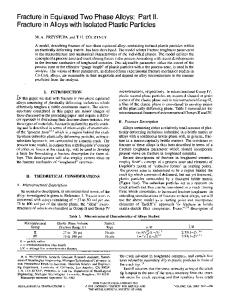Plastic deformation and fracture of binary TiAl-base alloys
- PDF / 5,461,404 Bytes
- 13 Pages / 597 x 774 pts Page_size
- 55 Downloads / 396 Views
I.
INTRODUCTION
THE intermetallic compound
TiA1 has attractive properties, such as a high melting temperature, low density, high modulus, and good oxidation resistance, r~'2r This compound thus has the potential for high-temperature structural applications, particularly if its low-temperature ductility and toughness can be improved. The deformation behavior of TiA1 (the y phase in the Ti-A1 system) is inherently related to its face-centered-tetragonal structure which orders in such a way that Ti and A1 atoms occupy alternating (002) planes. E3] Anisotropic deformation results, involving both 1/21110] unit dislocations and [101] and 1/21112] superdislocations. E4,51 Various core structures and dissociation reactions have been proposed for these dislocations, t*,5,6j It is worth noting that all proposed dissociations of superdislocations lead to the separation of a Shockley partial 1/61112], creating a {111} superlattice stacking fault. With regard to the understanding of the deformability of y-TiA1, there have been several important developments in recent years. (1) Shechtman et al. tTj showed that the 1/61112] Shockley partial is not continuously dissociated over the whole length of a superdislocation. Instead, sessile faulted dipoles are formed by local dissociation of superdislocations due to pinning of the 1/6(112) partials. The pinning, which is caused by a complicated jog mechanism according to Hug et al. ,ts] becomes unblocked only at temperatures above the ductile-brittle transition temperature (DBTT). t9] (2) Twinning on {111} planes, with the Shockley partial 1/61112] as the twin dislocation, is an important mode
SHYH-CHIN HUANG, Staff Metallurgist, and ERNEST L. HALL, Staff Scientist, are with Corporate Research and Development, General Electric Company, Schenectady, NY 12301. Manuscript submitted April 12, 1990. METALLURGICAL TRANSACTIONS A
of deformation, tTl This is shown by Huang and cow o r k e r s [1~ to be particularly true in the Ti-48 at. pct A1 composition, which contains Ti3A1 (a2) as a second phase. Plastic strains to failure greater than 2.5 pct have been measured in this alloy at room temperature, rl2,~31 These strain values are significantly higher than those (0.5 to 1 pct) reported for any single-phase y alloys. Another deformation character of this ductile two-phase alloy is the lack of superdislocation activity, since very few superdislocations (dissociated or undissociated) are found.[/~ u] (3) The mobility of the "easy-slip" 1/21110] dislocations has been called into question by Greenberg et al. r14] The unit dislocations are suggested to be trapped in deep Peierls stress valleys resulting from anisotropic chemical bonding. The results of Court et al. [nS] support this theory. (4) Superdislocations can be dissociated into sessile configurations, t16~which would prevent them from being either emitted from UTl or absorbed into I181a crack tip. A sessile configuration is usually transformed from a glissile configuration by cross slip of partial dislocations. This is typically a therm
Data Loading...











